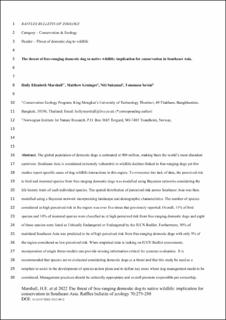| dc.contributor.author | Marshall, Holly Elizabeth | |
| dc.contributor.author | Grainger, Matthew | |
| dc.contributor.author | Sukumal, Niti | |
| dc.contributor.author | Savini, Tommaso | |
| dc.coverage.spatial | Sout-East Asia | en_US |
| dc.date.accessioned | 2022-07-07T08:10:36Z | |
| dc.date.available | 2022-07-07T08:10:36Z | |
| dc.date.created | 2022-04-19T13:14:29Z | |
| dc.date.issued | 2022 | |
| dc.identifier.citation | The Raffles bulletin of zoology. 2022, 70 275-288. | en_US |
| dc.identifier.issn | 0217-2445 | |
| dc.identifier.uri | https://hdl.handle.net/11250/3003391 | |
| dc.description.abstract | The global population of domestic dogs is estimated at 900 million, making them the world’s most abundant carnivore. Southeast Asia is considered extremely vulnerable to wildlife declines linked to free-ranging dogs, yet few studies report specific cases of dog-wildlife interactions in this region. To overcome this lack of data, the perceived risk to bird and mammal species from free-ranging domestic dogs was modelled using Bayesian networks considering the life history traits of each individual species. The spatial distribution of perceived risk across Southeast Asia was then modelled using a Bayesian network incorporating landscape and demographic characteristics. The number of species considered as high perceived risk in the region was over five times that previously reported. Overall, 11% of bird species and 10% of mammal species were classified as at high perceived risk from free-ranging domestic dogs and eight of these species were listed as Critically Endangered or Endangered by the IUCN Redlist. Furthermore, 50% of mainland Southeast Asia was predicted to be of high perceived risk from free-ranging domestic dogs with only 9% of the region considered as low perceived risk. When empirical data is lacking on IUCN Redlist assessments, incorporation of single threat models can provide missing information critical for accurate evaluation. It is recommended that species are re-evaluated considering domestic dogs as a threat and that this study be used as a template to assist in the development of species action plans and to define key areas where dog management needs to be considered. Management practices should be culturally appropriate and overall promote responsible pet ownership. Canis familiaris, dog-wildlife conflict, predation, Bayesian network, threat map | en_US |
| dc.language.iso | eng | en_US |
| dc.subject | Canis familiaris | en_US |
| dc.subject | dog-wildlife conflict | en_US |
| dc.subject | predation | en_US |
| dc.subject | Bayesian network | en_US |
| dc.subject | threat map | en_US |
| dc.title | The threat of free-ranging domestic dog to native wildlife: implication for conservation in Southeast Asia | en_US |
| dc.title.alternative | The threat of free-ranging domestic dog to native wildlife: implication for conservation in Southeast Asia | en_US |
| dc.type | Peer reviewed | en_US |
| dc.type | Journal article | en_US |
| dc.description.version | acceptedVersion | en_US |
| dc.rights.holder | © 2022 The Authors | en_US |
| dc.subject.nsi | VDP::Zoologiske og botaniske fag: 480 | en_US |
| dc.subject.nsi | VDP::Zoology and botany: 480 | en_US |
| dc.source.pagenumber | 275-288 | en_US |
| dc.source.volume | 70 | en_US |
| dc.source.journal | The Raffles bulletin of zoology | en_US |
| dc.identifier.doi | 10.26107/RBZ-2022-0012 | |
| dc.identifier.cristin | 2017560 | |
| dc.relation.project | Egen institusjon: King Mongkut’s University of Technology Thonburi’s | en_US |
| cristin.ispublished | true | |
| cristin.fulltext | postprint | |
| cristin.qualitycode | 1 | |
